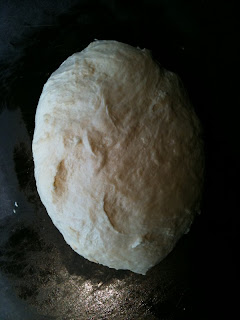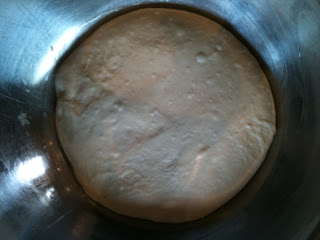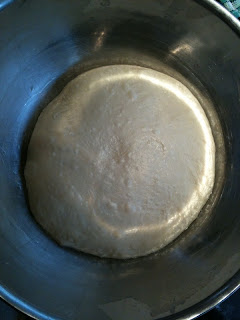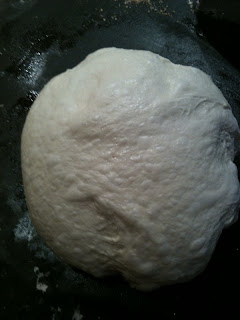I thought it'd be useful to do an entry with a step by step guide to sourdough.
Not, I will add quickly, because I am any sort of expert. But because I know a few people who are interested in 'getting into' sourdough and have been asking me questions about it, so I thought they might find it useful. But also there's nothing like someone who has just learned how to do something to explain it back to you. I know that I had a few questions when I first started (which was only a few months ago!) so this is really to help those that are even greener beginners than I.
Hopefully, you will have got yourself a copy of Dan Lepard's The Handmade Loaf, which is the book that got me on this incredibly exciting (je jeste pas) journey into artisan bread-making. You will have your starter, which is explained in great detail in his book. And you will know the basics of what you're doing. I'm not including a recipe here as this is really just to show you what to do regardless of which recipe you follow.
The equipment that I use and find useful:
A large stainless steel bowl, actually two.
A clean, baby muslin
A little whisk that I picked up from somewhere (Bakery Bits does a similar one here)
A dough scraper
A fork
You'll need
Flour - according to recipe
Cold water - according to recipe
Salt - I use Maldon sea salt ground in a mortar and pestle - according to recipe
All Dan's recipes ask for X g of starter. It took me a while to work out that if I didn't have the actual amount in my starter jar, it didn't matter. I could pour in what I had (not all of it! you always keep some starter to make more out from it), and then top it up with water and flour. But if you do this - i.e. feed the starter in a bowl to make more of it - you'll need to leave it for a few hours before it's ready.
For example. Let's say the recipe calls for 500g of starter. If you have that to spare in your jar, great. Spoon it in to a bowl. But what about if you don't really have that to spare?
After a while you will get to know roughly how much starter you have in your starter jar in the fridge. For example, I pretty much know I always have 200g of starter to spare, but I'm pushing it to get to 250g and I would never have a spare 500g in the jar.
So I get my bowl, put it on the scales and, for white leaven I measure out 100% of flour to 80% water (for a rye starter it's more like 100% floor to 90% water). So for example, I'd put in 150g of flour to 120g water, which weighs 350g on the scales. I then top that up with 150g of actual starter from my jar.
It sounds complicated, and sometimes the calculations do cause me to stare into space and bite my lip and ssssh my children if they try to talk to me, but you do get your head round it.
The easier way I remember it is that the ratio equates to:
100g flour to 80g water or,
125g flour to 100g water or,
150g flour to 120g of water, and I use those three formula calculationy things to muddle me along.
If you're using starter that's all straight from the starter jar, you can go straight onto 'first dough'.
If not then you you now mix up the starter with a fork or a whisk or a spoon until it's all incorporated (it will be quite thick). Leave it for a few hours until it's looser looking, more relaxed, with some bubbles. If you imagine that when you first mixed it up it was a bit uptight, top button done up, now it's slipped into a pair of velvet slippers and a smoking jacket and is having an evening smoke.
Remember to refresh your starter in the jar. I use 125g flour/100g of water or 100g flour/80g of water depending on how much space is in the jar.
First dough
I call this first dough, just cos. It's when you add the other ingredients to the starter, which will be
Flour
Water
Salt
according to the recipe that you're following. You add it all in and mix it around. The dough will look 'scrapy', with bits sticking out maybe.
Do not panic. Do not try to mix the dough until it's smooth. You will be there all day and start to cry. Believe that great things can happen.
 |
| This is a white sourdough dough after the very first mix. Looks pretty unruly huh? |
Let the dough rest for ten minutes; all of Dan's sourdough recipes ask for rests of
10min
10min
10min
30min
1hr
1hr
then it can vary to another 1hr or 2hrs. You'll need to see the recipe but once you've gone past the first 2/3 stages it's pretty much all of a muchness with a tiny knead and then a rest of X amount of time.
So, first rest of ten minutes. I just let it rest in the bowl I mixed it up in. The bowl will have scraps of dough around it and every time EVERY TIME, my partner says "can't you scrape them up into the dough".
And the answer is: no. It doesn't work like that. So you'll have a ball of scruffy looking dough, kinda dry looking (DO NOT be tempted to add more water), in a bowl with bits all over it. See the picture above.
Cover it with a dishcloth and bite your nails nervously. Set the timer for ten minutes.
In the meantime, oil a surface. I use sunflower oil and recommend you do too. Dan recommends olive oil, too, but he's probably richer than you or I. Sunflower oil is just fine. I use a big, big chopping board so that I can move my dough around the kitchen. Remember sourdough bread takes hours to make, so unless you are sure you can remain at the same work station unmolested, or don't mind clearing up after yourself each time, use a board. I also find a dough scraper invaluable. I got mine from Ikea, it's stainless steel, it's great. I use it when I go back to the dough after each rest to pick the dough up with and move it around. I also oil the board before each knead. Oil works great and doesn't alter the integrity of the dough. If you add flour or water, I found, you can get into a big sticky mess. Use oil, be brave.
After ten minutes, turn the dough out onto the board and start to knead gently. I do 12 kneads, sort of turning the dough in on itself, and around. Amazingly, you will see the dough start to get smoother. Don't panic if you've still got some bits that don't seem to quite adhere, and it's not yet as smooth as it could be, although by this stage you should have a dough with promise.
 |
| This is the same dough as above, but after its rest of ten minutes and its first knead. Big difference isn't there? |
Now: either oil a bowl and put the dough in it, covering it with a cloth (I use the baby muslins for this, but a dishcloth would do fine, obviously you don't need to have had a baby and have baby muslins to do this FFS) or put the dough on the surface you just kneaded it on and cover it with an oiled bowl.
If you have lots of large stainless steel bowls, like I do, then lucky you. You don't need to wash up just yet. Otherwise you'll need to wash up the doughy-bowl, dry it, oil it and put it to use.
Set the timer for un'altre ten minutes.
 |
| This is the same white sourdough dough, after its third lot of ten minute rises. |
At each stage the dough will have relaxed a little and started to grown. At first, when you're only leaving it for 10 or 30 mins, you won't notice it so much. But when you get to the longer proving times, you'll see how it stretches out and relaxes. When you first get back to the dough you'll also feel how it's softer and starts to stiffen up as you knead it.
Don't be tempted to knead it more than 10-15 seconds.
 | ||
| Et voila le dough after the first one hour rise. You can see bubbles on the surface yes? Good sign. |
 | ||||
| After the second, 1hr rise. The dough is bigger, more relaxed, smoother. A bit like me after Christmas. |
 |
| Here it is after its 2hr rise. Just before it's shaped and put into a banneton for its overnight sleep. |
I should point out that the bread-heads always say that if it's warm (like a hot sunny day or just if your kitchen is warm) then you might be able to leave your bread for less time, say 40 minutes instead of an hour. I've never bothered with this particularly and always do what time suits me. Equally, if you leave the bread for longer than ten minutes (or 30mins or an hour or whatever rest you're on), cos the phone goes, or Corrie is on, it doesn't matter either. Obviously you can't completely take the piss, but sourdough is a bit like a very loving/drunk parent/partner: it is very forgiving.
When you've done your resting and kneading for the last time, you shape it into a ball, let it rest for ten minutes and then shape it into the final shape you want and put it to prove in a lined bowl or banneton for the last rise of whatever the recipe says (usually about 4hrs or so). I always do the final prove (prove = rise) in the fridge, cos that's what works for me. I leave it for 10-36hrs for white dough, and up to 72 hours for wholemeal/rye etc. I haven't experimented with longer than that yet.
In the morning this is what I do: I preheat the oven to 220C. I put in two baking trays, the one I will bake the bread on goes on the top shelf. The tray I will put the ice cubes on will go on the bottom shelf. Don't use your best tray for the ice cubes.
When the oven is up to temperature, fill a glass with ice cubes and get your polenta ready. Take out the top baking tray - the one that will receive the bread - and dust it with polenta. You can't put the polenta on before this (i.e. at the time of first putting the tray in the oven) or it will burn.
Turn the bread out onto the polenta. This is where the linen lined bannetons really come into their own, because it makes the process easy.
 | ||
| These are the loaves, turned out onto a polenta dusted tray and slashed. |
When you've slashed, put the bread into the oven, and just before shutting the door, pour the ice cubes onto the bottom tray. They will fizz and steam. That's good. That steam will keep the bread moist. If you have a water sprayer, you should also spray the top of the bread. This is important because once the crust has hardened, the bread can no longer rise, so the longer you can leave it before the crust hardens, the more chance you have of 'oven spring' - the bread making that final push upwards in the oven.
Things that really make a difference:
Slashing - your bread won't be so aerated without it.
Ice cubes - you won't get such a good crust or so much rise.
Preheated baking tray - you won't get such a good crust or such a good rise.
Polenta - you can do without it, but it produces a really professional finish, even if it is only on the bottom.
 |
| The finished product |
That's it!







